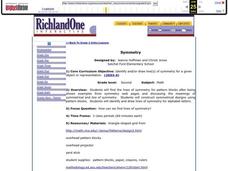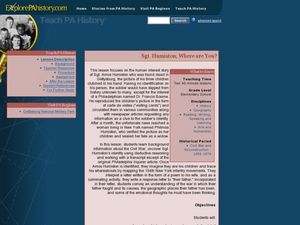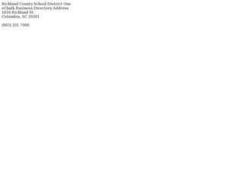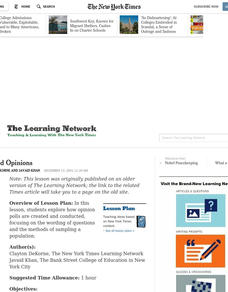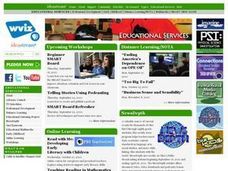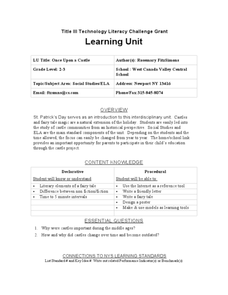Curated OER
The Aftermath of Genocide
Students read and discuss articles written about the Rwandan genocide. They participate in a class discussion, and write a letter to the U.N. or a letter to the editor of their local newspaper.
Curated OER
Symmetry
Second graders find the lines of symmetry in pattern blocks and alphabet letters. In this symmetry lesson, 2nd graders discuss what symmetry is, view examples of lines of symmetry and apply what they have learned by finding the line of...
Curated OER
Learning to Interview
Second graders watch simulated interview between the teacher and a student before they interview a classmate using the form provided. Next, they complete two interviews of family members at home. They focus on the concepts of ancestors...
Curated OER
Sgt. Humiston, Where are You?
Students become familiar with the events of the Civil War. In this identification lesson, students use deductive reasoning to understand how the deceased soldier was identified. Students view primary documents for information about the...
Curated OER
Critical Literacy in the 21st Century
Listen to Sitti's Secrets and have your class discuss their opinions about Arab families. They will become familiar with the Palestinian /Arabic Culture through a critical literacy focus. Young scholars will write a persuasive letter...
Curated OER
Hurricane Katrina: You Be the Reporter
Students work in a small group to create news stories, feature stories and editorials/letters to the editor and organize them in a podcast, video-based program, or newspaper/magazine focused on Hurricane Katrina.
Curated OER
To Your Health
Students focus on how storks and other cultural icons, in both Bulgarian and American customs, are believed to encourage and bring good health. They list three natural phenomena in their region prominently associated with the coming of...
Curated OER
Waking Up, Stepping Out
Young scholars focus on a rich and colorful description of a culture unfamiliar to most of them. They compare the similarities and differences they find between Nepali culture and their own and determine our similarities as people can...
Curated OER
Short Story Lesson Plan
Students read and discuss the short story, "The McWilliamses and the Burglar Alarm," by Mark Twain. They assume the role of the main characters in the story and write a humorous letter of complaint using a business letter format. They...
Curated OER
Symmetry
Third graders find symmetry in nature. In this symmetry lesson, 3rd graders discover that symmetry is in nature and our everyday world. Students examine the alphabet for symmetrical letters then create their own artwork showing symmetry.
Curated OER
Elements Compounds and Mixtures
In this science worksheet, students apply science basic knowledge of chemistry to the puzzles that are listed for the four parts of the sheet while focusing upon the identification of a metalloid.
Curated OER
Atomic Energy
In this science worksheet, students use basic scientific concepts to complete the series of puzzles while focusing upon atomic energy by exploring alpha, beta, and gamma decay.
Curated OER
Quiz 3A: Expressions of Quantity
As part of this activity focusing on the use of the expressions all of, almost all of, most of, some of and none of, learners evaluate groups of symbols to identify the information missing. In the first part of this 14 question activity,...
Curated OER
Dear Me
Students take a classroom "gallery walk" memorializing 9/11. As a class, they read and discuss the article "A Day to Clear the View, and Remember." Then, they write letters focusing on events that have made them want to alter their life...
Curated OER
Am I Seeing Double?
Students explore symmetrical design and lines of symmetry. In this fourth grade geometry lesson, students create their own symmetrical design and identify and label the lines of symmetry. Students use one design to create a card to...
Curated OER
President Obama's Address to Students Across America
Students listen to President Obama's speech, and discuss its meaning. In this President Obama lesson students learn about the president, about how to deliver a speech, and the ways they can make a difference. They create posters, write...
Curated OER
Dear Mrs. Roosevelt
Students develop an understanding of how the Great Depression impacted people. In this writing, analyzing and cooperative groups lesson, students inquire about the Great Depression. Students identify problems children faced during this...
Curated OER
Looking at Life through the Creation of Personal Metaphors
Young scholars focus on the creation of personal metaphors, which are first illustrated in pictures and caricatures and then extended to descriptive/analytical paragraphs. They teach the lesson to others using their own personal...
Curated OER
High Crimes and Misdemeanors
Students analyze the Constitution's wording regarding impeachment and discuss the impeachment process. They then design a survey based on student-generated questions about the charges against President Clinton and write a letter to the...
Curated OER
Coral Reef Conservation
Students conduct discussions on current threats to coral reefs around the world and write letters to conservation organizations urging support for coral reef protection.
Curated OER
Measured Opinions
Students read "Public Is Wary but Supportive on Rights Curbs," at the New York Times online. They explore how opinion polls are created and conducted, focusing on the wording of questions and the methods of sampling a population.
Curated OER
The Problem with Prejudice
Third graders read and discuss "The Hangman" by Maurice Ogden and answer questions about the poem. They list things they can do to combat prejudice using each of the letters in the word and create a small poster with a slogan against...
Curated OER
Master Spy
Students explain that a code is a system of symbols, letters, words, or signals that are used instead of ordinary words and numbers to send messages or to store information. They practice deciphering a variety of secret codes used in...
Curated OER
Once Upon a Castle
Students complete a variety of activities surrounding castle communities and fairy tales. They write a letter to a fairy tale character, write a fairy tale, create a model of a castle, and draw a map of a castle community.



